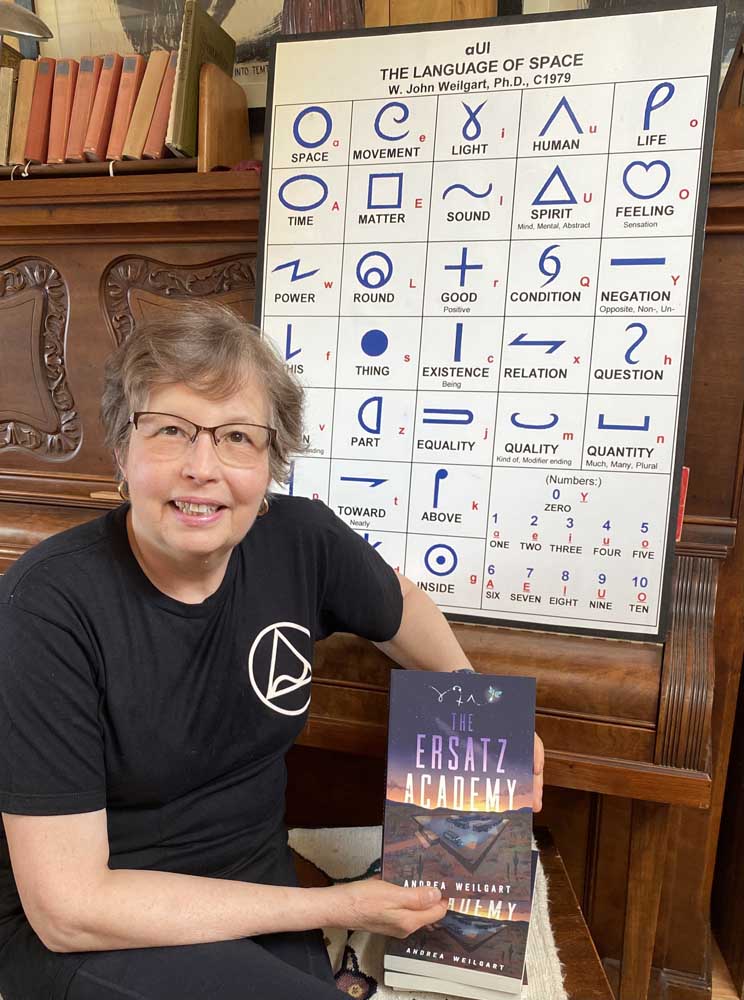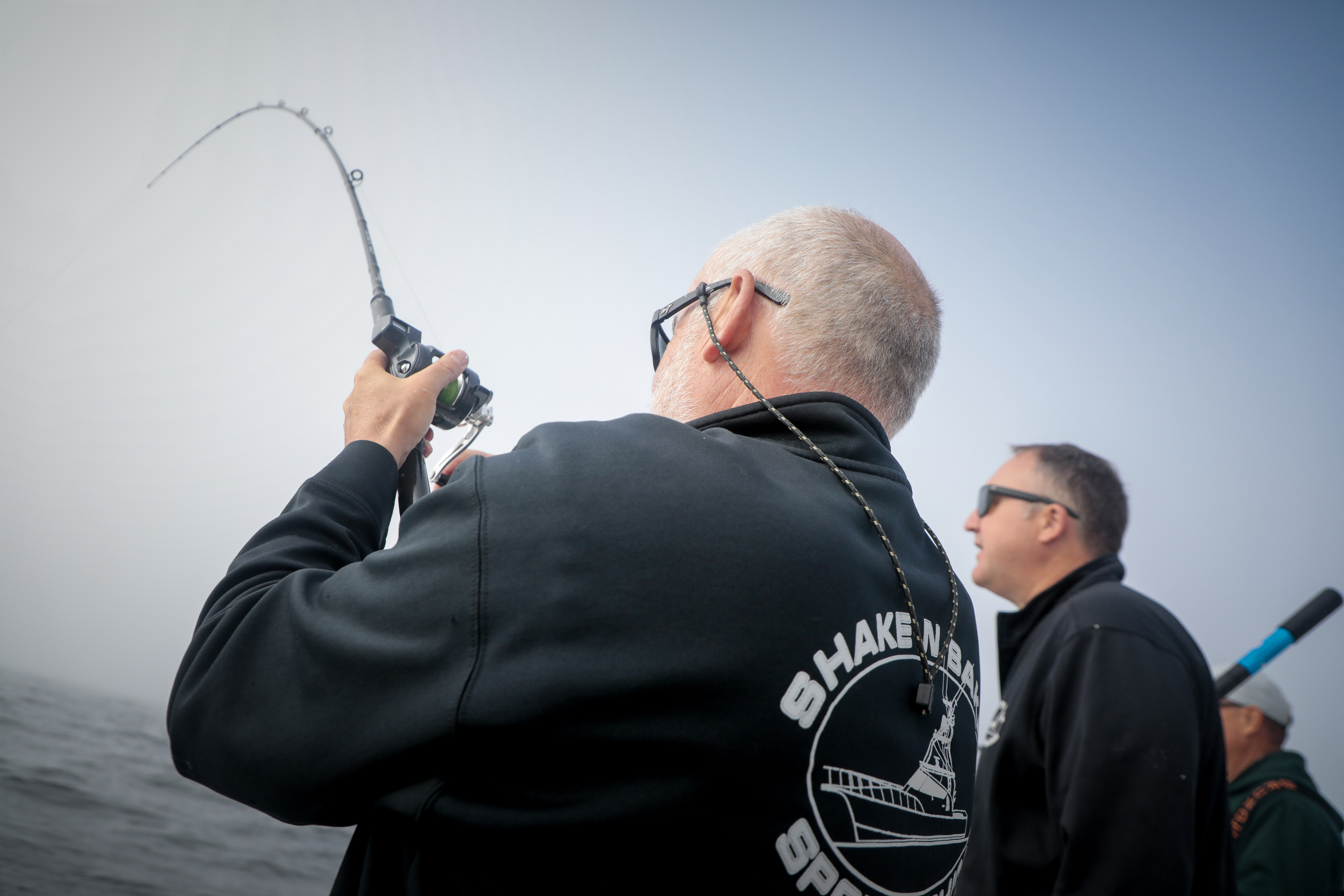Coast Chronicles: Andrea Patten and the Language of Space
Published 7:27 am Monday, May 8, 2023

- Andrea Patten and her just-published novel “The Ersatz Academy.” Her father W. John Weilgart created the Language of Space ( on the chart behind her), a central factor in the story.
How to begin?
So many of us have complex and bewildering relationships with our parents, and Andrea “Andi” Patten is no different. She has spent most of her life trying to come to terms with, clarify, and promote the work of her father, W. John Weilgart, a philosopher, psychoanalyst and philologist.
The process of growing up and figuring out who we are in the world as individuals is sometimes made more complicated by having illustrious or particularly talented parents, and that is certainly the case for Andi having a dad like John — an Austrian intellectual and the creator of a special language he called aUI (ah-oo-ee) or the Language of Space. Weilgart created this language based on what he felt were the basic elements common to any human living on planet earth — a language made up of 31 “basic building blocks,” as if they were atoms in a periodic table that could be combined into new meaning structures.
Weilgart’s language is visual (each word has a symbol) as well as spoken and begins with such words/elements as space, time, power, movement, matter, light and human. Each symbol represents a concept or word and has an associated sound.
As Weilgart wrote, “symbols that are like the universe’s atomic elements combine into molecules of meaning… a cosmic logos for truth and wisdom that keep pointing us back to reality, to the basic elements of our world.” For instance, when the two symbols, one for light, followed by one for action/make/verb are written or spoken together they mean “shine.” Or another example: when the symbol for mind is paired with action/make/verb that means “think.” Add “light” to “mind” and “action” and you get “understand.”
Weilgart goes on to explain aspirations for his language, “Where there was confusion and discord, this cosmic speech brings an inner harmony between sound, symbol and meaning. The miniature world of the mind mirrors the immense world of the universe in the symbols of the Language of Space.”
The Language of Space
Andi and her sister grew up immersed in this Language of Space, as her father called it. They both were integral to the informal seminars he conducted in their small house and later at Luther College in Iowa. “My sister and I grew up with his creation and learned it by osmosis.” They were conscripted to assist by drawing the language symbols on a large slate blackboard, by speaking the language in sentences and dialogues, and later by typing up the voluminous manuscripts their father created. Sometimes they were at these secretarial duties all day, working on an IBM typewriter in an office at Luther College.
It was a rarefied and intense childhood. Her father’s dream was to have the Language of Space be universally known, accepted, and utilized. As Andi says, “It was a family mission.” One year when her father arranged for a sabbatical in Germany, the whole family packed up and moved; but he was called away almost immediately back to the U.S. to work at a naval drug rehabilitation center as a psychotherapist. (Meanwhile the family stayed in Germany.) He provided assistance to disturbed military veterans, sometimes using the tools of his Language of Space to help them understand themselves better.
Andi remembers this year fondly because she loved being outside and with a German farming family making hay and milking cows. As Andi says, “I discovered my love was farming and agriculture. That may have happened as a sort of antagonism to my father, but I fell in love with the farm and the family there. They took me in and I just sort of worked my butt off. I loved being there on the farm.”
The family returned to the states and Andi eventually went on to college, first at Luther College, then to Iowa State where she met Kim. (They’ve been married 44 years!) “When I met Kim we lived happily ever after,” says Andi. “We were not weighed down with the burden of my father’s mission.” But still at the back of her mind was her father’s language and how she might create a framework for it that would broaden its appeal and application.
“Kim and I moved to the Peninsula in 1990. But just shortly before we moved here, I spent some time at the University of Texas at Tyler in their research library trying to find a reference that would provide some scientific basis for my father’s work. I wanted to justify the creation of his language on an academic level.”
Spark of an idea
So it was at the University of Texas that Andi found references to the experimental work cited earlier by her father. It was the seminal work of Russian American and experimental psychologist Gregory Razran and his concept of “semantic conditioning” — basically a training procedure in which a target physical response is repeatedly stimulated and paired with a key word until the two are inseparable. Sort of like the Pavlovian bell followed by a dog’s food appearing, such that the bell itself, even without the presentation of food, stimulates a dog’s saliva.
This idea about the power of words and linking up words with behavior — for good or evil — got her thinking. Andi had been exploring the notion of a book that would explain the Language of Space and she felt that in Razran’s concept she’d hit upon a notion that might be useful in creating a narrative plot for a story. Her recently published book “The Ersatz Academy” is the result.
‘The Ersatz Academy’
I don’t want to give too much away about this intriguing and wonderful tale but I can say that Andi has neatly, even expertly, woven together many themes relevant for our times. The story is written for young adults — they are the heroes in the story — but I enjoyed all its many facets. We’ve got a great tale with a touch of sci-fi, references to AI, lessons for how to be kinder, explicit dangers captured in the academy’s “zombie-subjects” (AKA students), illustrations of the importance of critical thinking, a diverse cast of characters, and — even more amazingly — an introduction to the Language of Space, renamed in the novel the Language of Light. (There is a glossary of both the major building block symbols and how they fit together into phrases.) You might say her father’s language is one of the main characters, or perhaps even the hero of the story.
No wonder it has taken Andi decades to land on just the right way to synthesize her experience of the Language of Space. When she was a child, I’ll bet she had no idea she would end up on a small beautiful Peninsula on the Pacific Coast — with an a amazingly productive garden — working on a Y.A. novel!
As Andi says about the whole process of writing the book — all of which was a totally new experience for her, “It was all so time consuming, the whole project took five years. It was a real struggle: the writing, deciding which parts of the language to use, not letting the language overshadow the story. The editing took two years. I worked four years with an Australian ghost writer. Then we disagreed about how the book should end. She wanted something more dramatic involving the FBI. I wanted an ending which fit with the essential concepts of the language.” (The ending is perfect.)
About writing this novel featuring the special language her father created — with all its associated memories, complexities, and challenges — Andi says, “It’s taken a lifetime!”
Come hear more about Andi’s story, see how the Language of Space works, and listen to her read parts of this compelling novel “The Ersatz Academy,” Saturday, May 13, from 1 to 3 p.m. in the community room of the Ocean Park Timberland Library.









